CHEVROLET CAVALIER 1993 1.G Owners Manual
Manufacturer: CHEVROLET, Model Year: 1993, Model line: CAVALIER, Model: CHEVROLET CAVALIER 1993 1.GPages: 308, PDF Size: 15.62 MB
Page 191 of 308
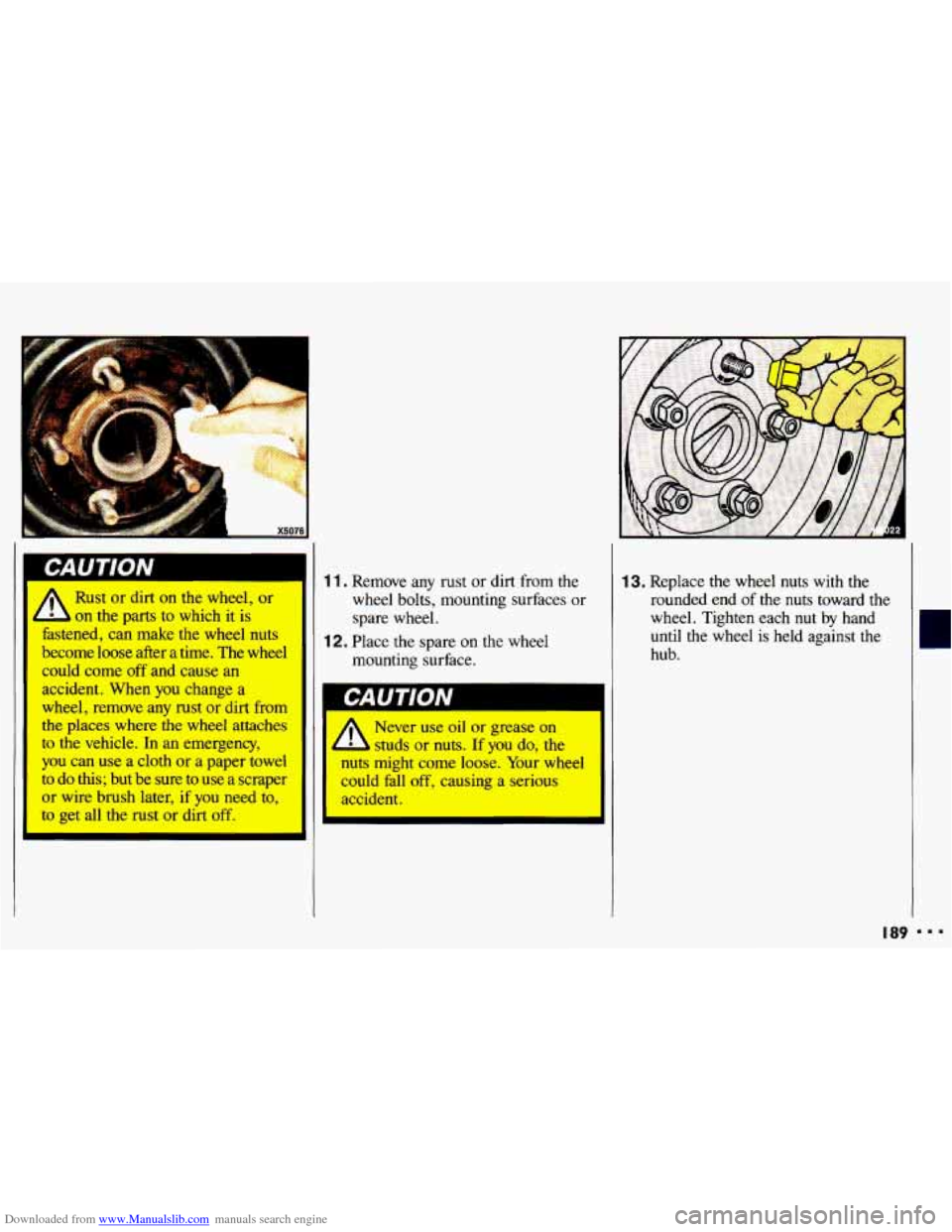
Downloaded from www.Manualslib.com manuals search engine Ll X5076
Rust or dirt on the wheel, or
on the parts to which it is
fastened, can make the wheel nuts
become loose after a time. The wheel
could come off and cause an
accident. When
you change a
wheel, remove any rust
or dirt from
the places where the wheel attaches
to the vehicle. In an emergency,
you can use a cloth
or a paper towel
to do this; but be sure to use a scraper
or wire brush later, if you need to,
to get all the rust or dirt off.
1 1. Remove any rust or dirt from the
wheel bolts, mounting surfaces or
spare wheel.
mounting surface.
1 2. Place the spare on the wheel
~ CAUTION
13. Replace the wheel nuts with the
rounded end of the nuts toward the
wheel. Tighten each nut by hand
until
the wheel is held against the
hub.
A
Never use oil or grease on
studs or nuts. If
you do, the
nuts might come loose. Your wheel
could fall off, causing a serious
accident.
I89
Page 192 of 308
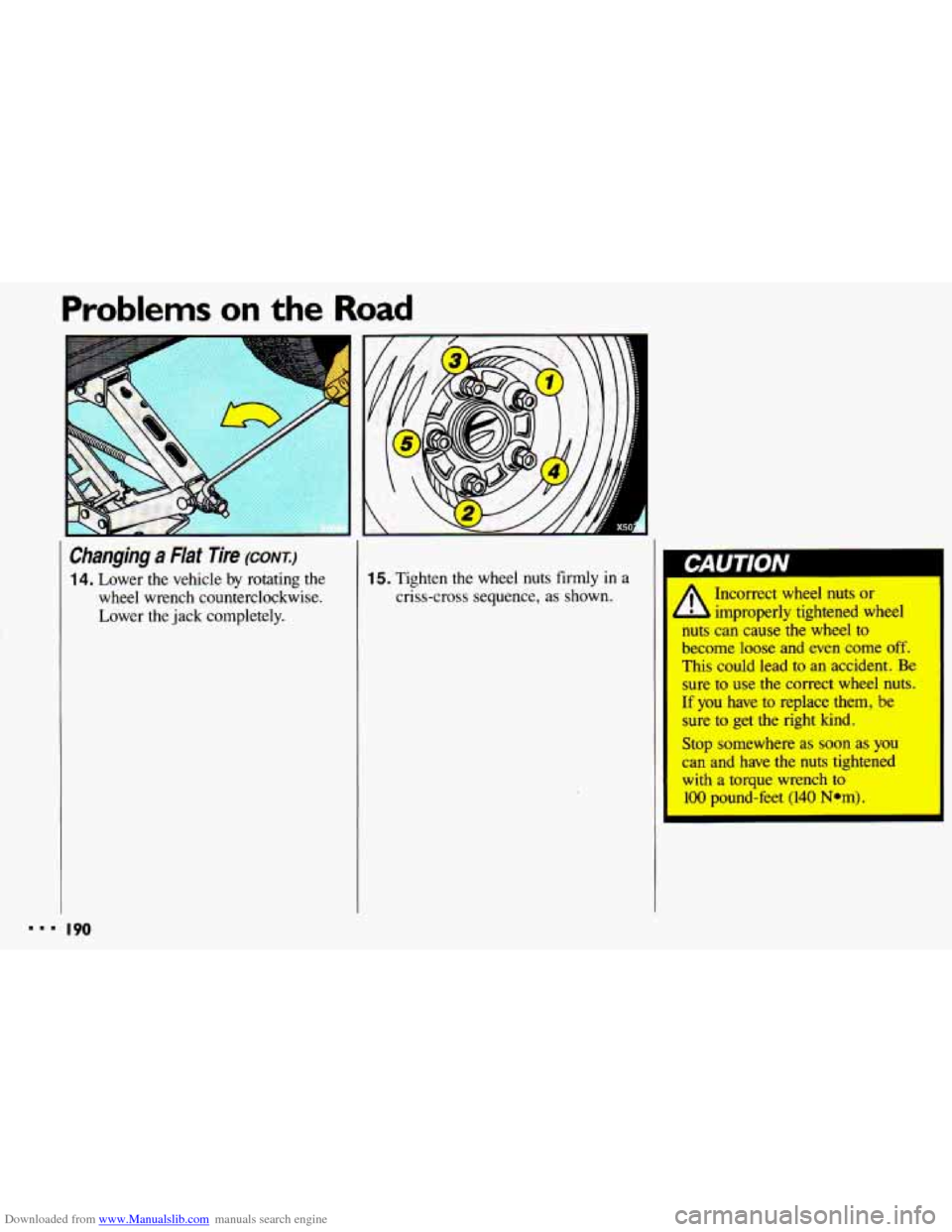
Downloaded from www.Manualslib.com manuals search engine Problems on the Road
Changing a Flat Tire (CONT)
14. Lower the vehicle by rotating the
wheel wrench counterclockwise.
Lower the jack completely. 15. Tighten the wheel nuts firmly in a
criss-cross sequence, as shown.
I
Incorrect wheel nuts or
1 L improperly tightened wheel
nuts can cause the wheel to
become loose and even
come off.
This could lead to an accident. Be
sure to use the correct wheel nuts.
If you have to replace them, be
sure to get the right kind.
Stop somewhere as soon as you
can and
have the nuts tightened
with a torque wrench to
100 pound-feet (140 Nom).
Page 193 of 308
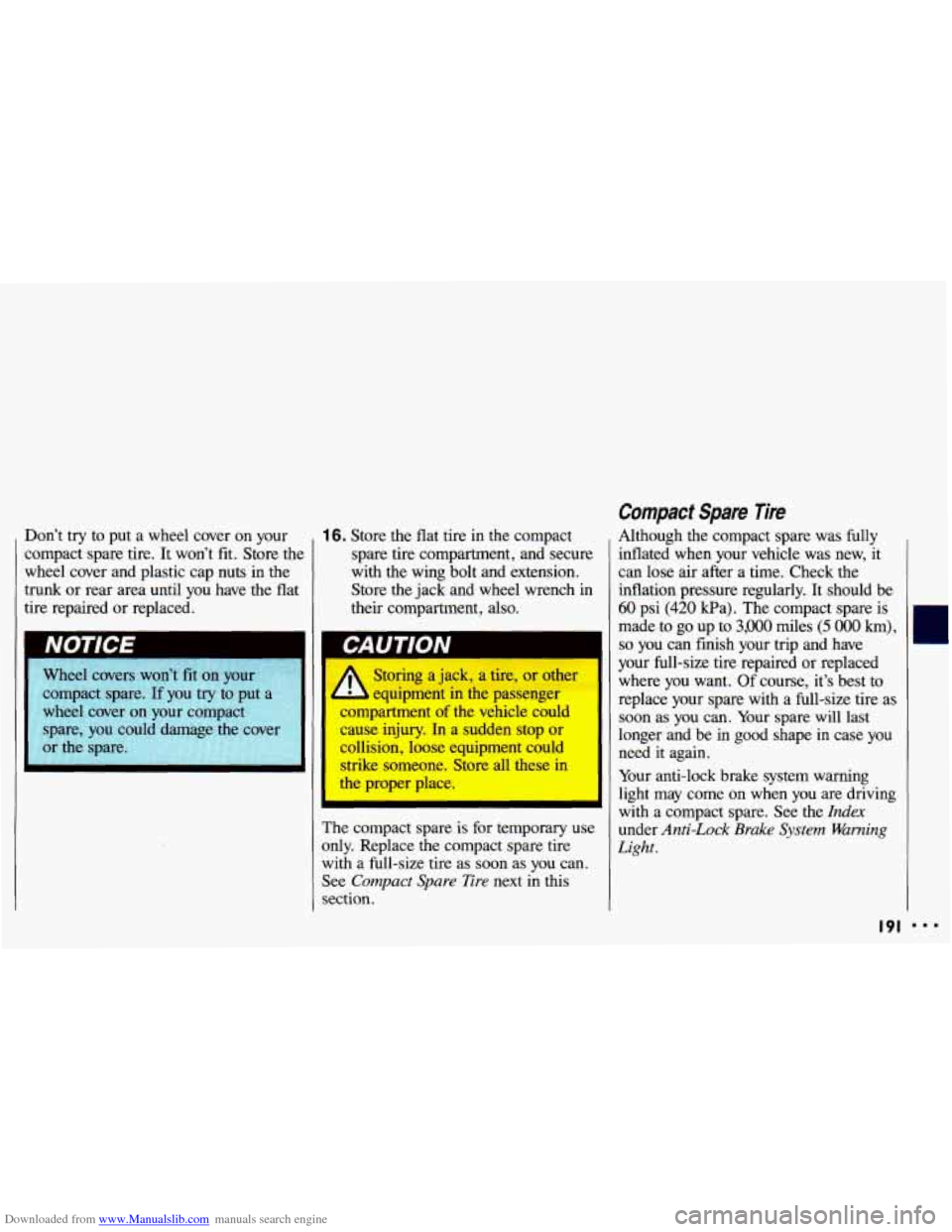
Downloaded from www.Manualslib.com manuals search engine Don’t try to put a wheel cover on your
compact spare tire.
It won’t fit. Store the
wheel cover and plastic cap nuts in the
trunk or rear area until you have the flat
tire repaired or replaced.
16. Store the flat tire in the compact
spare tire compartment, and secure
with the wing bolt and extension.
Store the jack and wheel wrench in
their compartment, also.
MU I IVN 1
Storing a jack, a tire, or other
:quipment in the passenger
compartment
of the vehicle could
cause injury. In a sudden stop
or
collision, loose equipment could
strike someone. Store all these in
the proper place.
The compact spare is for temporary use
only. Replace the compact spare tire
with a full-size tire as soon as you can.
See
Compact Spare Tire next in this
section.
Compact Spare Tire
Although the compact spare was fully
inflated when your vehicle was new, it
can lose air after a time. Check the
inflation pressure regularly.
It should be
60 psi (420 Wa). The compact spare is
made to go up to
3,000 miles (5 000 km),
so you can finish your trip and have
your full-size tire repaired or replaced
where you want.
Of course, it’s best to
replace
your spare with a full-size tire as
soon as you can. Your spare will last
longer and be in good shape in case you
need it again.
Your anti-lock brake system warning
light may come on when you are driving
with a compact spare. See the
Index
under Anti-Lock Brake System Warning
Light.
191
Page 194 of 308
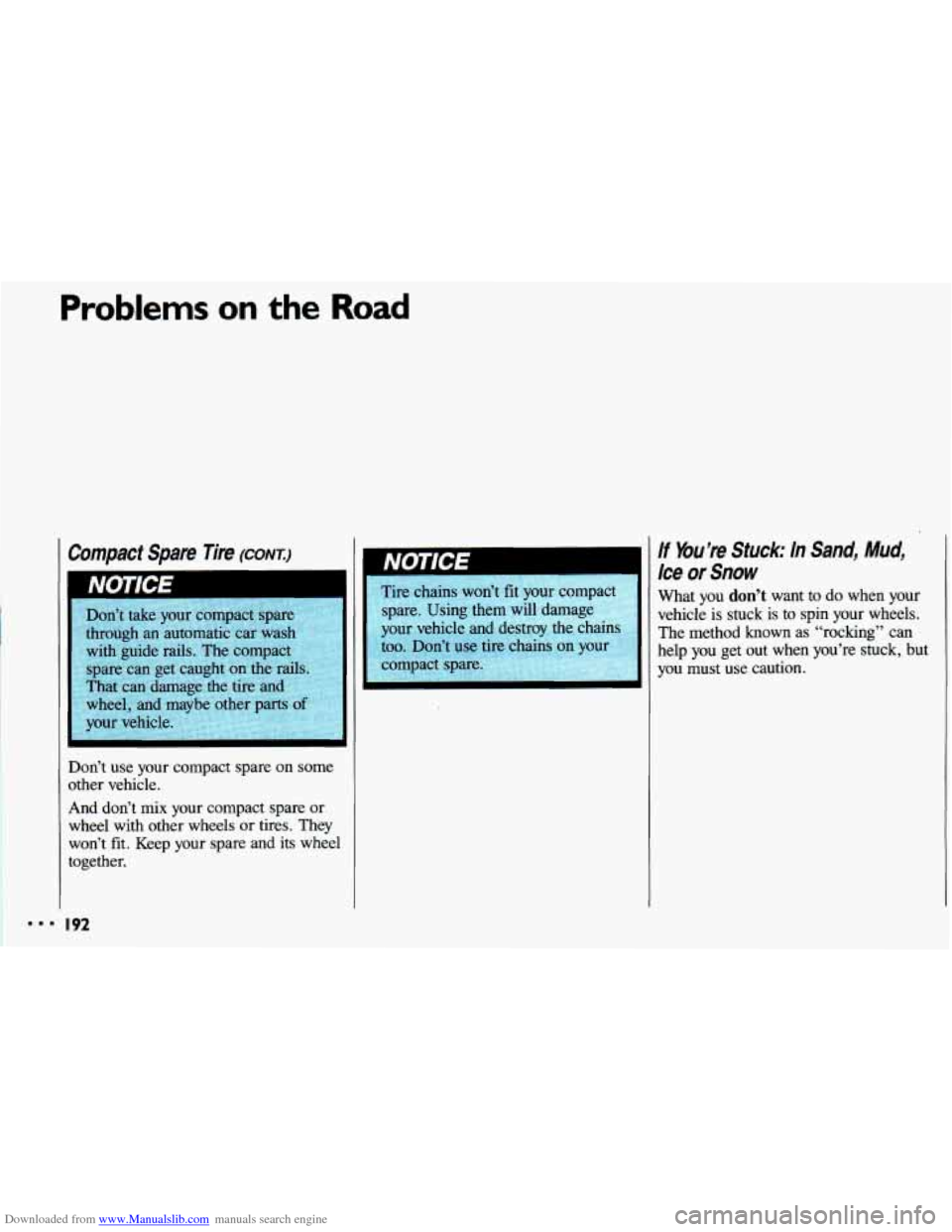
Downloaded from www.Manualslib.com manuals search engine Problems on the Road
Compact Spare Tire (CONT.)
Don't use your compact spare on some
other vehicle.
And don't
mix your compact spare or
wheel with other wheels or tires. They
won't fit. Keep your spare and its wheel
together.
I92
Tire spare. chains Using won't them=! fit your compact ;$
your vehicle and destroy the chains""'"
too. Don't use tire chains on your
compact spare.
lf You're Stuck: In Sand, Mud,
lce or Snow
What you don't want to do when your
vehicle is stuck is to spin your wheels.
The method known as "rocking" can
help 'you get out when you're stuck, but
you must use caution.
Page 195 of 308
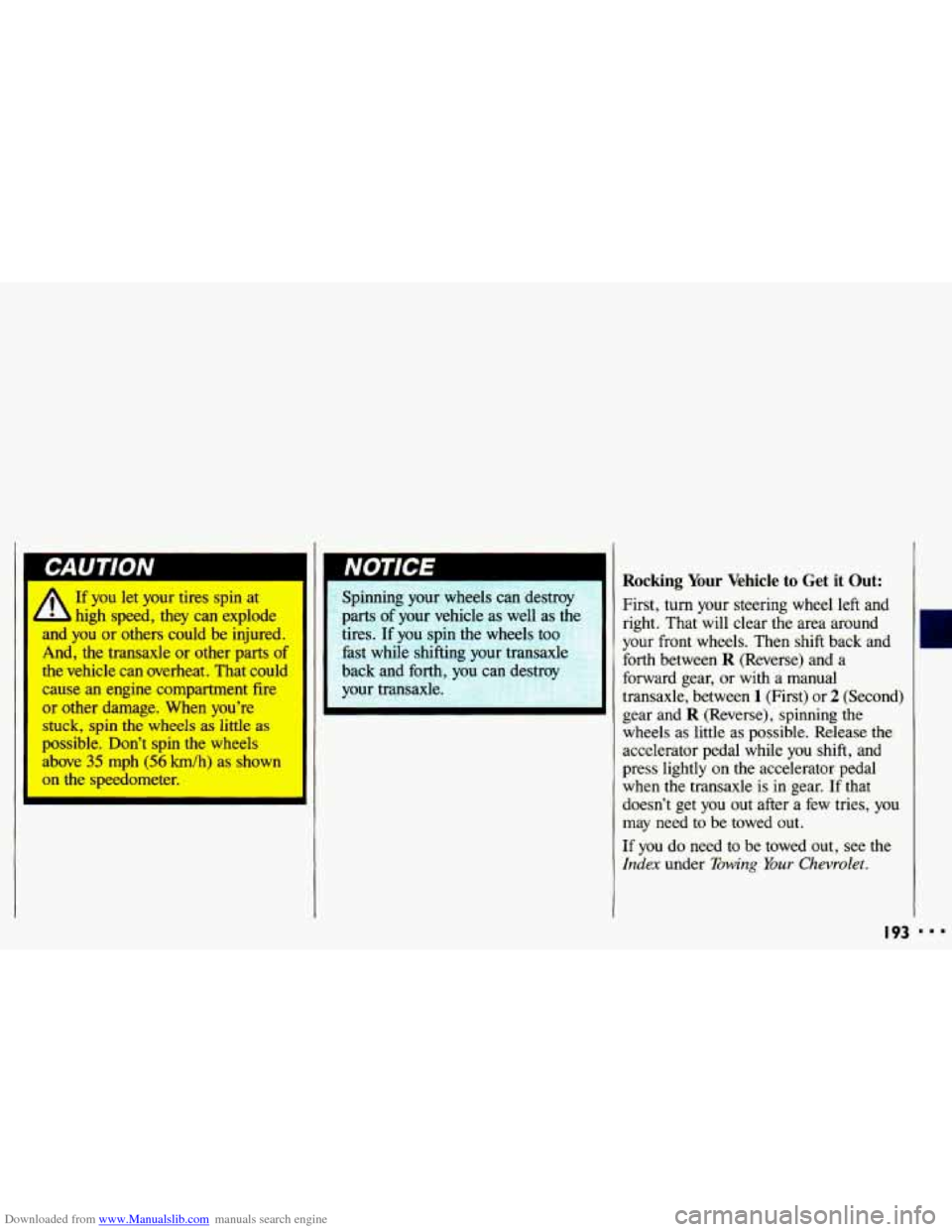
Downloaded from www.Manualslib.com manuals search engine If you let your tires spin at
- high speed, they can explode
and you or others could be injured.
And, the transaxle or other parts of
the vehicle can overheat. That could
cause an engine compartment fire
or other damage. When you’re
stuck, spin
the wheels as little as
possible. Don’t spin the wheels
above
35 mph (56 h/h) as shown
on
the speedometer. Spinning
your wheels can destroy
parts
of your vehicle as well as the
tires.
If you spin the wheels too
fast while shifting your transa:
back and forth, you can destroy
your transaxle.
-
Rocking Your Vehicle to Get it Out:
First, turn your steering wheel left and
right. That will clear the area around
your front wheels. Then shift back and
forth between
R (Reverse) and a
forward gear, or with a manual
transaxle, between
1 (First) or 2 (Second)
gear and
R (Reverse), spinning the
wheels as little as possible. Release
the
accelerator pedal while you shift, and
press lightly on the accelerator pedal
when the transaxle is in gear. If that
doesn’t get you out after a few tries,
you
may need to be towed out.
If
you do need to be towed out, see the
Index under Towing Your Chevrolet.
I93
Page 196 of 308
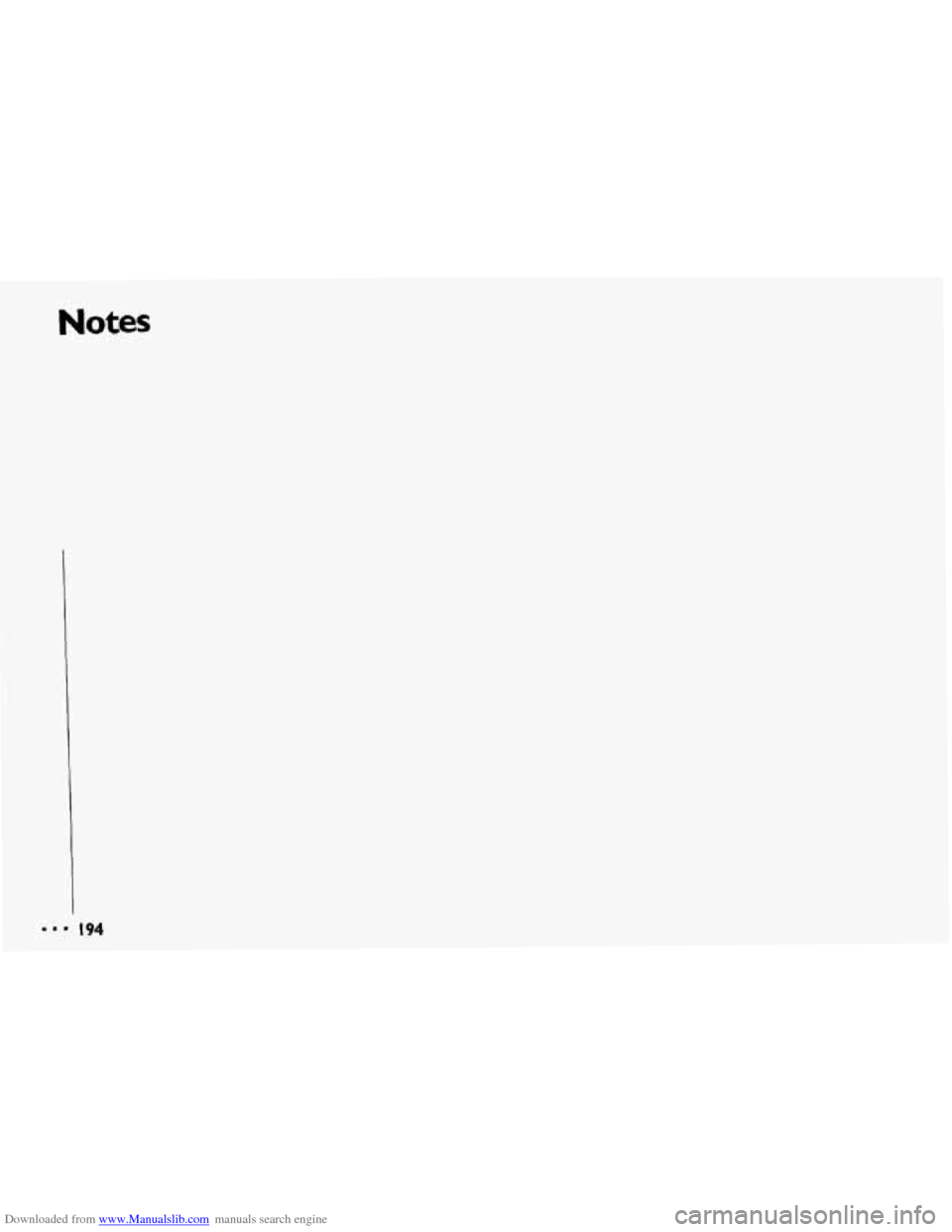
Downloaded from www.Manualslib.com manuals search engine Notes
194
Page 197 of 308
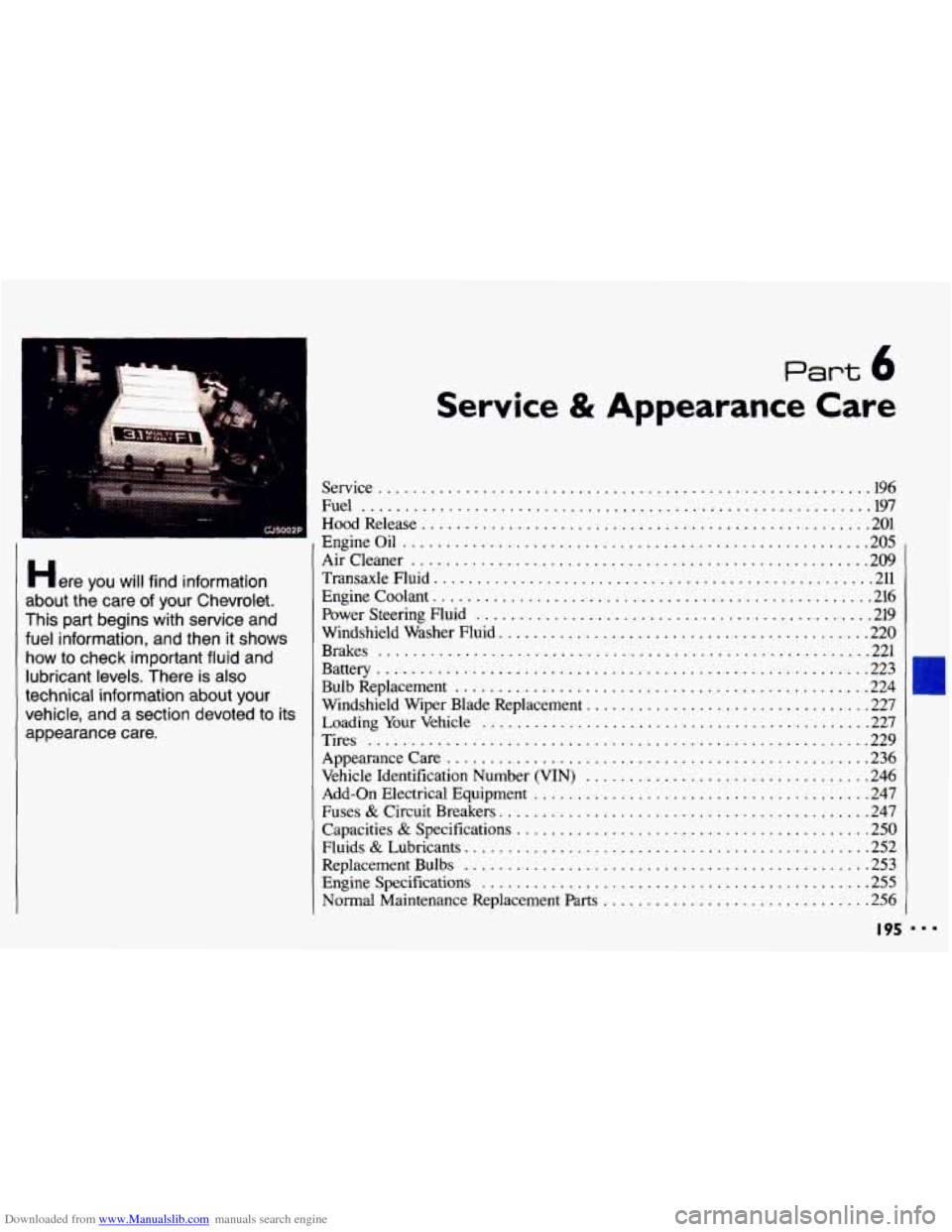
Downloaded from www.Manualslib.com manuals search engine i
.....
.................................. ...................
........ ... . &5
..... ..... .... .. --
' . I .. ~
Here you wit1 find information
about the care
of your Chevrolet .
This part begins with service and
fuel information. and then
it shows
how to check important fluid and
lubricant levels
. There is also
technical information about your
vehicle. and
a section devoted to its
appearance care
.
Part 6
Service & Appearance Care
Service ......................................................... 196
Fuel ........................................................... 197
HoodRelease
.................................................... 201
EngineOil
...................................................... 205
Aircleaner
..................................................... 209
Transaxle Fluid
................................................... 211
Engine Coolant
................................................... 216
Power Steering Fluid
.............................................. 219
Windshield Washer Fluid
........................................... 220
Brakes
......................................................... 221
Battery
......................................................... 223
BulbReplacement
................................................ 224
Windshield Wiper Blade Replacement
................................. 227
Loading
Your Vehicle ............................................. 227
Vehicle Identification Number (VIN)
................................. 246
Add-on Electrical Equipment
....................................... 247
Fuses
& Circuit Breakers ........................................... 247
Capacities & Specifications ......................................... 250
Fluids & Lubricants ............................................... 252
Replacement Bulbs
............................................... 253
Engine Specifications
............................................. 255
Normal Maintenance Replacement
Parts ............................... 256
Tires .......................................................... 229
Appearancecare
................................................. 236
I95
Page 198 of 308
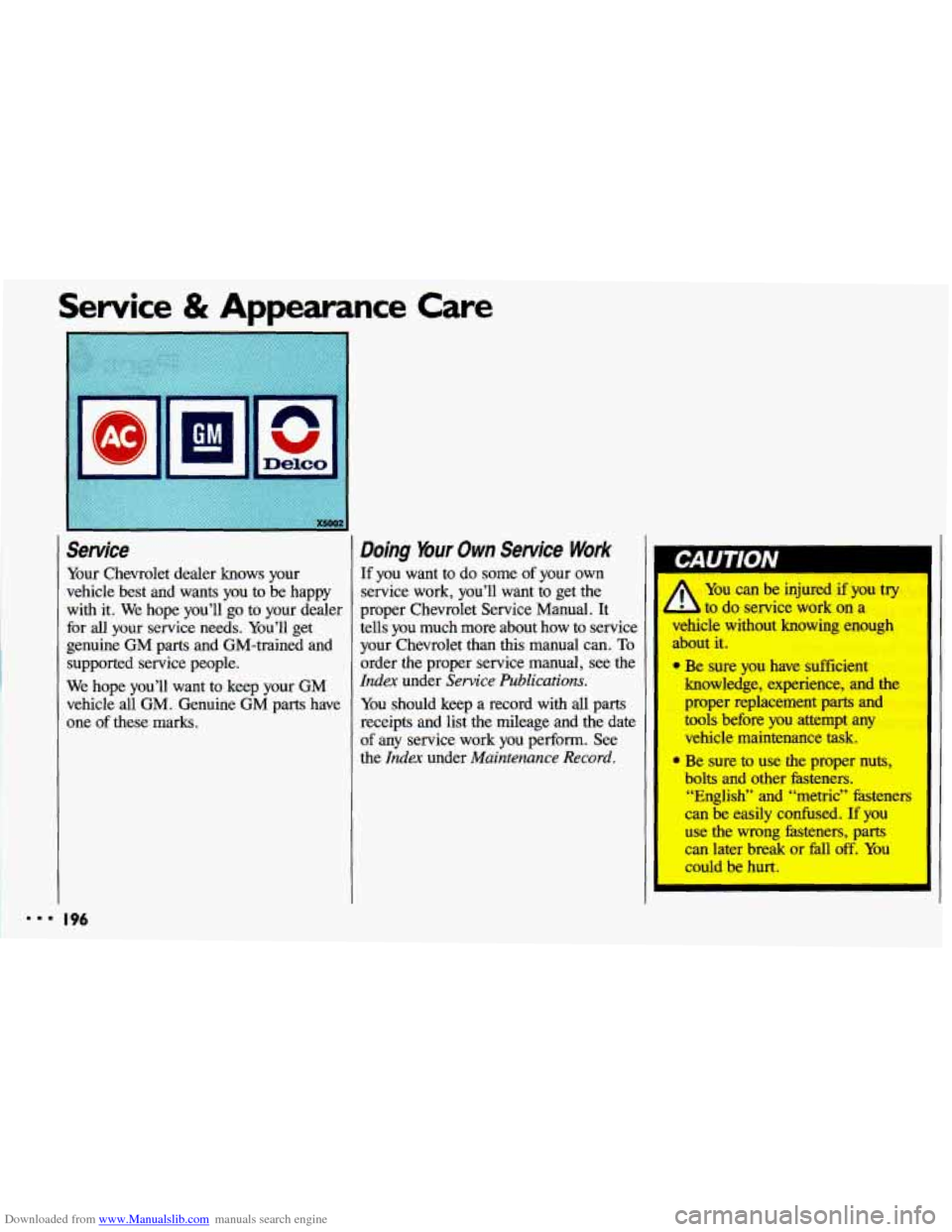
Downloaded from www.Manualslib.com manuals search engine Service & Appearance Care
Service
Your Chevrolet dealer knows your
vehicle best and wants you to be happy
with it. We hope you’ll
go to your dealer
for all your
service needs. You’ll get
genuine GM parts and GM-trained and supported service people.
We hope you’ll want to keep your GM
vehicle all GM. Genuine GM parts have
one of these marks.
196
Doing Your Own Service Work
If you want to do some of your own
service work, you’ll want
to get the
proper Chevrolet Service Manual.
It
tells you much more about how to service
your Chevrolet than this manual can.
To
order the proper service manual, see the
Index under Service Publications.
You should keep a record with all parts
receipts and list the mileage and the date
of any service work you perfom. See
the
Index under Maintenance Record.
-- --
A You can be injured if you try
vemcle without knowing enough
about it.
* Be sue you have sufficient
- I to do service work on a
knowledge, experience, aud the
proper replacement parts and
vehicle maintenance task.
Be sure to use the proper nuts,
bolts and other Edsteners.
“English” and “metric” fhsteflers
can be easily confbsed. If you
use the mng fasteners, parts
can later break or fhll off. You
tools befare you attempt any
Page 199 of 308
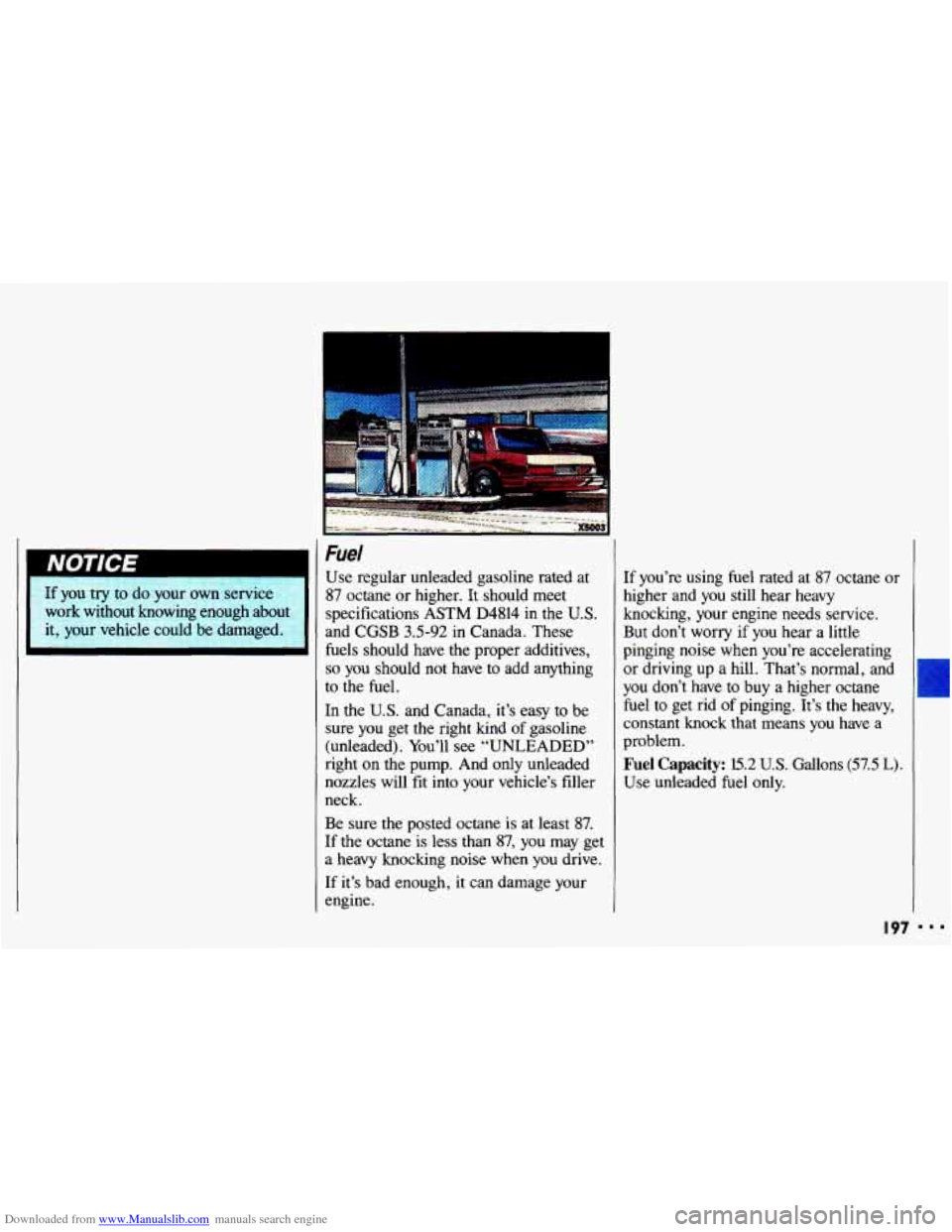
Downloaded from www.Manualslib.com manuals search engine If you try to do your own servic
work without knowing enough abot it, your vehicle could be damaged.
Fuel
Use regular unleaded gasoline rated at
87 octane or higher. It should meet
specifications ASTM D4814 in the U.S.
and CGSB
3.5-92 in Canada. These
fuels should have the proper additives,
so you should not have to add anything
to the fuel.
In the U.S. and Canada, it’s easy to be
sure you get the right kind
of gasoline
(unleaded). You’ll see “UNLEADED”
right on
the pump. And only unleaded
nozzles will
fit into your vehicle’s filler
neck.
Be sure the posted octane is at least
87.
If the octane is less than 87, you may get
a heavy knocking noise when you drive.
If it’s bad enough, it can damage your
engine.
If you’re using fuel rated at 87 octane or
higher and
you still hear heavy
knocking, your engine needs service.
But don’t worry
if you hear a little
pinging noise when you’re accelerating
or driving up
a hill. That’s normal, and
you don’t have to buy a higher octane
fuel to get rid of pinging. It’s the heavy,
constant knock that means
you have a
problem.
Fuel Capacity: 15.2 U.S. Gallons (57.5 L).
Use unleaded fuel only.
I97
Page 200 of 308
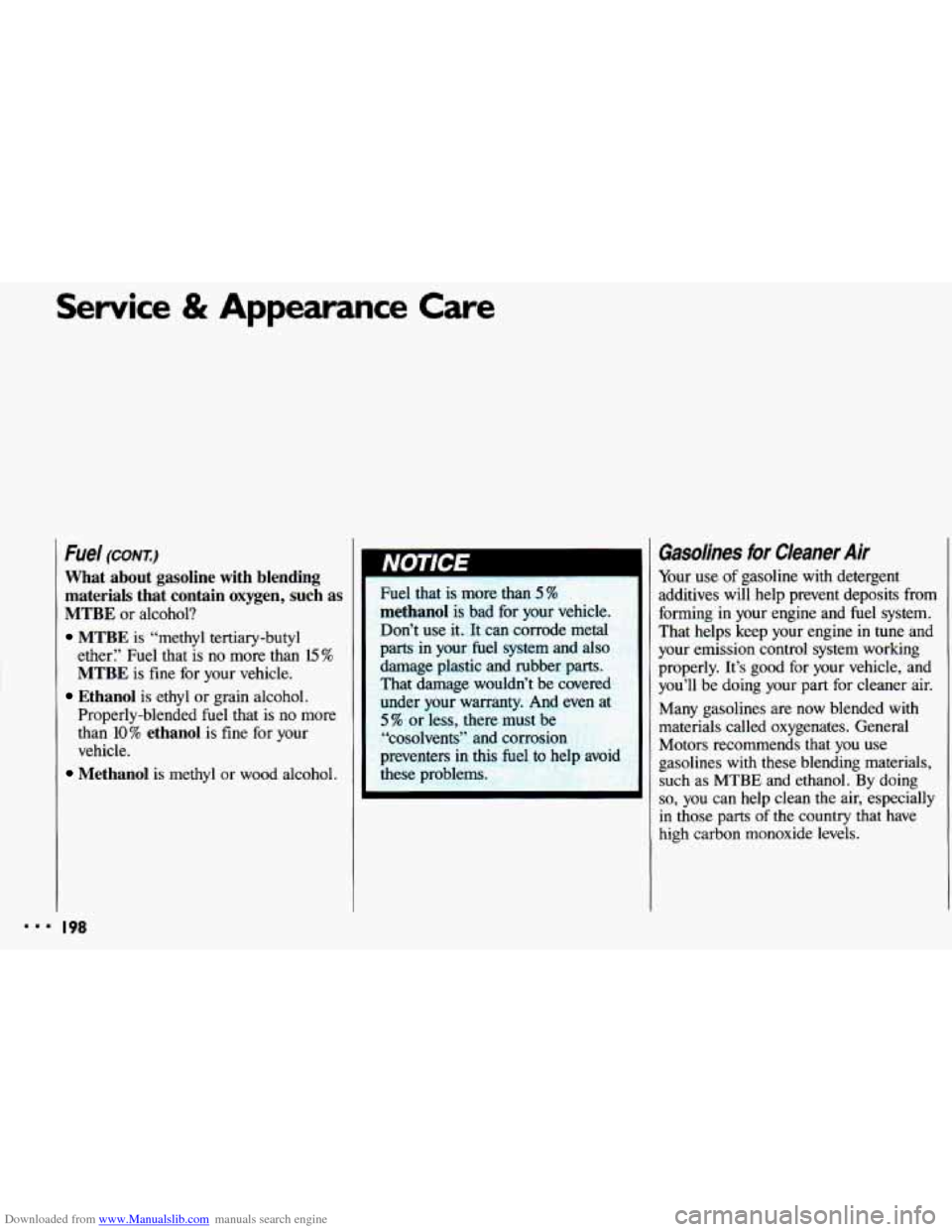
Downloaded from www.Manualslib.com manuals search engine Service & Appearance Care
Fuel (CONTI
What about gasoline with blending
materials that contain oxygen, such
as
MTBE or alcohol?
MTBE is “methyl tertiary-butyl
ether?
Fuel that is no more than 15 %
MTBE is fine for your vehicle.
Ethanol is ethyl or grain alcohol.
Properly-blended fuel that is
no more
than
10% ethanol is fine for your
vehicle.
Methanol is methyl or wood alcohol.
I98
Fuel that is more than 5 %
methanol is bad for your vehicle.
Don’t use it.
It can corrode metal
parts in your fuel system and also
damage plastic and rubber
parts.
That damage wouldn’t be covered
under
your warranty. And even at
5 % or less, there must be
“cosolvents” and corrosion
preventers in th he1 to :lp avoid
these problems.
- -
Gasolines for Cleaner Air
Your use of gasoline with detergent
additives will help prevent deposits from
forming
in your engine and fuel system.
That helps keep your engine
in tune and
your emission control system working
properly. It’s good for your vehicle, and
you’ll be doing your part for cleaner air.
Many gasolines are now blended
with
materials called oxygenates. General
Motors recommends that you use
gasolines with these blending materials,
such as MTBE and ethanol. By doing
so, you can help clean the air, especially
in those parts of the country that have
high carbon monoxide levels.